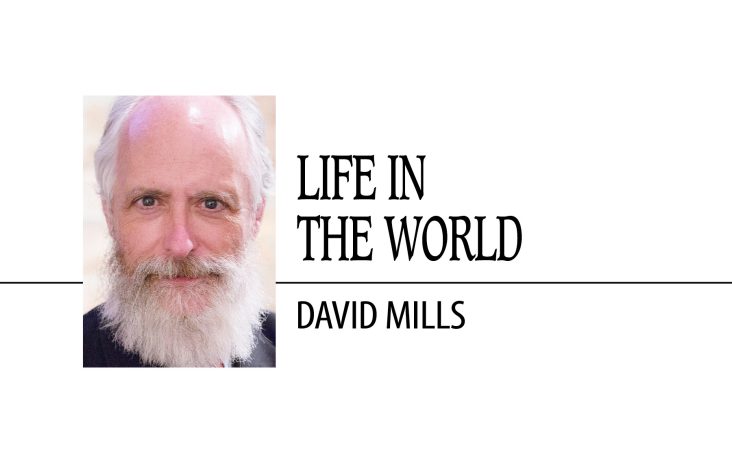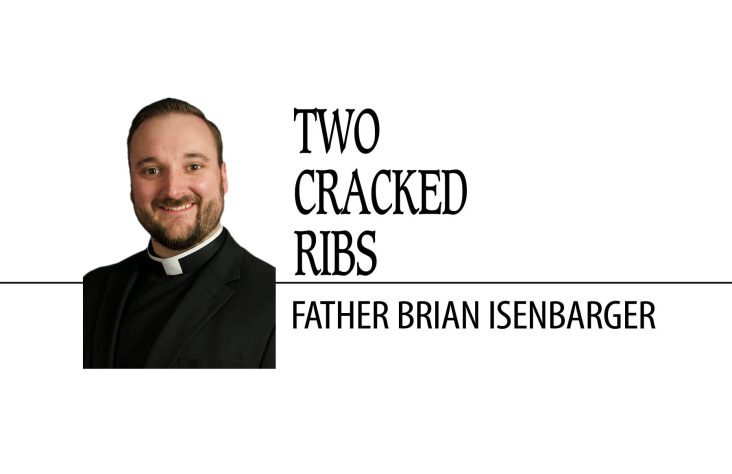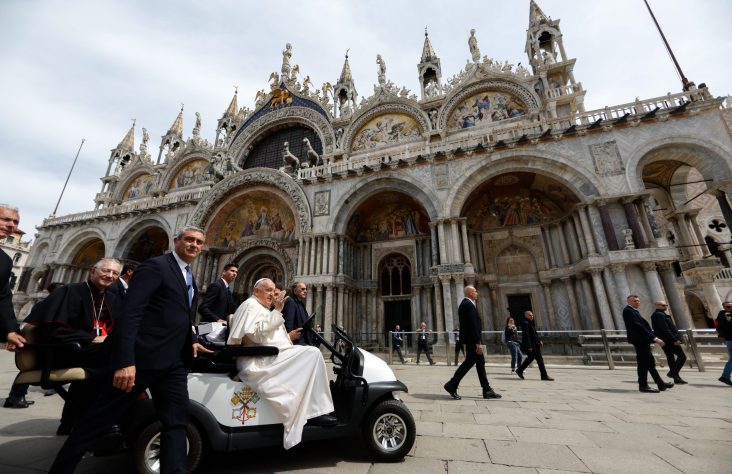April 2, 2013 // Uncategorized
Bishop Rhoades celebrates Easter, Triduum
For more Easter and Triduum photos visit the photo gallery.
By Tim Johnson
The theme of “light” pervades the Easter Vigil. From blessing the Easter fire on the plaza of the Cathedral of the Immaculate Conception, to blessing the Easter candles and singing three times “Christ our Light,” with the response, “thanks be to God,” to the singing of the “Exsultet” to the Scriptural readings of the night, the theme of light is evident.
“My brothers and sisters, our column of fire, our sacred cloud, is the Risen Christ, symbolized by the lighted Paschal candle,” said Bishop Kevin C. Rhoades in his homily at the Easter Vigil Mass. “He is our light. The history of salvation, recounted in our readings tonight, culminates in the One who is the Light of the World. The Easter Vigil is fundamentally the celebration of the new creation in Christ.”
Bishop Rhoades said, “The Resurrection is like a great explosion of God’s light in history, an explosion of love: God’s victory over the powers of darkness, over sin and death. And we can share in this victory, this new life. We can become new creatures. Is this not what happens in the sacraments of Christian initiation: Baptism, Confirmation and the Holy Eucharist? These sacraments are the anticipation of the new world, its presence anticipated in our lives. We rejoice that our catechumens and our candidates will receive these sacraments tonight.”
But all Catholics are called to renew their Baptismal promises, their commitment to follow Christ, “to build our life on Him and for Him, and to live His Gospel,” Bishop Rhoades said.
“The light which breaks forth from His resurrection reveals the definitive victory of love, joy and life over evil, suffering and death,” Bishop Rhoades concluded in his homily. “May that light fill the souls of those who will now receive the sacraments of initiation!”
The Easter Vigil, the greatest night of the Church, was one of several Triduum and Easter liturgies Bishop Rhoades celebrated.
With just a little snow remaining on the north side of the cathedral grounds, hundreds gathered in downtown Fort Wayne for the celebration of the Easter Vigil with Bishop Rhoades.
The “mother of all Vigils” began at 8:35 p.m. on Saturday evening, a half-hour after sunset, as all gathered outside on the cathedral plaza.
Upon re-entering a darkened cathedral with the Easter candle, the candle light symbolizing the light of Christ quickly spread among the congregation holding individual votive candles.
Deacon Chris Lapp, who is scheduled to be ordained a priest this summer, served several key roles in the liturgy: carrying the Easter candle, singing solo the “Exsultet,” reading the Gospel, and remaining close at Bishop Rhoades’ right side throughout the liturgy. Three adults were baptized, confirmed, and received their first Holy Communion: Christin Gimbel, Christopher Karami, and Sarah Wright. Also Christopher Karami’s infant daughter Olive was baptized in the same font as her father.
On Easter Sunday, Bishop Rhoades celebrated two Masses for the prisoners at the Allen County Jail in Fort Wayne.
Triduum celebrations
The triduum celebrations began Holy Thursday with a Mass celebrated by Bishop Rhoades at the Cathedral of the Immaculate Conception.
“It was no mere coincidence that Jesus gathered the Twelve Apostles on the feast of Passover to celebrate His Last Supper with them,” Bishop Rhoades noted in his homily.
“For the Apostles and all the Jewish people, this was the feast of feasts,” Bishop Rhoades said. “After God instructed Moses and Aaron how to prepare and eat the first Passover before the Exodus, He told them that that day would be a memorial feast for them and that all generations would celebrate it as a perpetual institution.”
“Jesus chose this very important Jewish feast for the Last Supper,” Bishop Rhoades continued. “It is significant that our Lord chose this feast that recalled the night when God freed Israel from slavery in Egypt for His Last Supper with the Apostles.”
Bishop Rhoades said it is very striking that when reading the accounts of the Last Supper in the New Testament, the Passover lamb is nowhere mentioned.
“Instead of the Passover lamb, Jesus takes the unleavened bread and a cup of wine and makes them the principal part of the meal,” Bishop Rhoades said. “Instead of the lamb, Jesus took the bread and called it His own Body. ‘Take, eat; this is my Body,’ Jesus said. Instead of the lamb’s sacrificial blood, Jesus took a cup of wine and spoke of His own blood being poured out in sacrifice. He was re-enacting what would happen the next day, Good Friday. He broke the bread — His own Body would be broken on the cross. The cup of blood was poured out — His own blood — would be poured out on Calvary. Jesus was identifying Himself with the Passover lamb.”
Bishop Rhoades noted, “The Holy Eucharist is the center of our life — it is the new Passover of the new covenant. Every time we gather for Mass, Christ’s Passover is made present: the sacrifice Christ offered once for all on the cross remains ever present in His Church, the new Israel.”
After the homily, Bishop Rhoades demonstrated again Jesus’ example of humble service at the Last Supper by washing, drying, and kissing the feet of 12 diocesan seminarians seated near the front steps of the sanctuary.
The cathedral’s tabernacle was empty with its doors wide open throughout Mass. After Communion, Bishop Rhoades, servers, choir, and the congregation processed solemnly out the main doors with the Holy Eucharist, over to the St. Mother Theodore Guérin Chapel. The Holy Eucharist was venerated and then reposed in the chapel for Adoration. More than 50 Mass participants remained with the Holy Eucharist to pray, recalling Jesus’ night of anguish in the Garden of Gethsemane before His crucifixion.
Good Friday was celebrated by Bishop Rhoades at St. Matthew Cathedral in South Bend.
Bishop Rhoades spoke of the death of Jesus on the cross.
“With the passion and death of Jesus, God’s love for us, for humanity, is manifested in all its depth and intensity,” he said. “The cross is the decisive proof of God’s love. As St. Paul wrote: ‘God showed His love for us in that while we were yet sinners, Christ died for us.’”
“God showed His solidarity with humanity, not only by becoming man, but by humbling Himself, as St. Paul wrote, even unto death, death on a cross,” Bishop Rhoades added. “Jesus willingly carried the cross and embraced both physical and moral suffering, all for love of us, to liberate us from sin and death.”
Bishop Rhoades recalled the presences of St. John at the foot of the cross: “He saw Jesus, the Son of God, embracing in His human heart the Father’s love for us, loving us to the end. He heard Jesus’ prayer of pure love: ‘Father, into Your hands I commend My spirit.’ He saw Jesus bow His head and hand over the spirit, the Holy Spirit, the Spirit breathed forth to dwell in our hearts, also symbolized by the water that flowed from the pierced side of Jesus.”
“On Golgotha, at the crucifixion, John saw God’s inner life opened to us,” Bishop Rhoades continued. “And he saw the world being reconciled to God. The Father, Son, and Holy Spirit accomplish the single act of our redemption.”
After Jesus’ death, St. John saw the soldier thrust his lance into Jesus’ side. He saw the blood and water immediately flow out from the pierced side of Christ.
“The Fathers of the Church saw this double outpouring of blood and water as an image of the sacraments of the Eucharist and Baptism, flowing forth from the heart of Jesus,” Bishop Rhoades said.
“The most profound mystery of the Church is that of being the sacrament of Trinitarian love,” Bishop Rhoades said. “We are a community of disciples rooted in the love with which Christ loved us. The Church was born from the pierced side of Christ, from His Sacred Heart. We, the members of His Body, the Church, are called to love Him and in Him, one another “This is the new outpouring that creates the Church and renews mankind.”
He concluded the homily by noting, “On the third day, St. John would enter the tomb and find it empty. He who witnessed the climax of the revelation of God’s love on Good Friday would also witness the triumph of that love on Easter Sunday.”
Joe Romie contributed to this story.
The best news. Delivered to your inbox.
Subscribe to our mailing list today.





